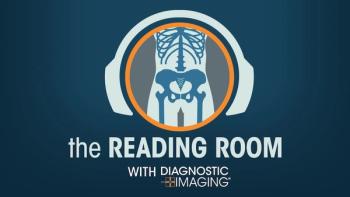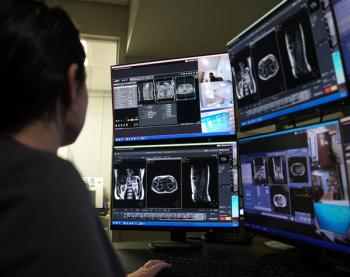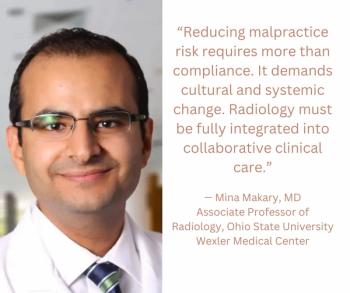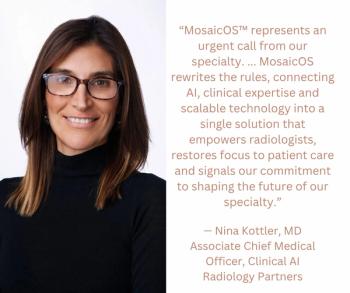
While the research reveals key benefits with portable imaging, particularly point-of-care ultrasound applications with AI capabilities, these authors note challenges with variability in training and advocate for radiologist-led oversight.

While the research reveals key benefits with portable imaging, particularly point-of-care ultrasound applications with AI capabilities, these authors note challenges with variability in training and advocate for radiologist-led oversight.

Amid the worsening imbalance of supply and demand in radiology and concerning scope of practice issues, one must keep in mind that course correction is often gradual in nature.

In a new podcast, Krishna Nallamshetty, M.D., shares his thoughts on key contributing factors to burnout in radiology, and discusses practical approaches and emerging technology that may help mitigate the issue.

In the second part of a recent interview, Chris Mattern. M.D., discussed the increasing burden of non-clinical tasks upon radiologist workloads and the potential of the emerging enterprise imaging platform MosaicOS to address efficiency and restore the focus on clinical care.

Emphasizing advanced orchestration of imaging workflows, the Rhapsody Image Director software reportedly facilitates streamlined efficiency and infrastructure that accommodates multimodal AI tools.

In a recent interview, Tammie Benzinger, M.D., Ph.D., discussed the utility of portable low-field MRI to help identify patients in remote settings who may be viable candidates for subsequent MRI workup and consideration for new anti-amyloid therapies in treating Alzheimer’s disease.

Catch up on the top radiology content of the past week.

In addition to facilitating centralized scanning for a variety of imaging, the TechLive system may help ease the strain of technologist shortages and broaden access to advanced imaging exams.

In light of the ongoing challenges with navigating malpractice risk and administrative burdens in radiology, these authors issue a call for increased communication and collaboration with ordering clinicians.

In a recent interview, Chris Mattern, M.D., discussed a confluence of trends that may be contributing to burnout in radiology, early retirements and a shifting preference from full-time to part-time roles in radiology.

Lower proportions of extremely dense breasts and high BRCAT lifetime risk among Black women in comparison to White women may have resulted in a lower likelihood of eligibility for supplemental screening insurance coverage in Pennsylvania, according to new research.

In the third of a three-part podcast episode, Emanuel Kanal, M.D. and Tobias Gilk, MRSO, MRSE, discuss strategies for maintaining the integrity of time-out procedures and communication with remote MRI scanning.

Catch up on the top AI-related news and research in radiology over the past month.

Catch up on the top radiology content of the past week.

In the second of a multi-part podcast episode, Emanuel Kanal, M.D. and Tobias Gilk, MRSO, MRSE, share their perspectives on remote MRI safety protocols for ensuring screening accuracy and adherence to conditional implant guidelines as well as a rapid and effective response to adverse events.

In the first of a multi-part podcast episode, Emanuel Kanal, MD and Tobias Gilk share their insights and perspectives on remote MRI safety.

From adjusting to the rules of early childhood games to understanding the nuances of tax law and the ‘One Big Beautiful Bill,’ adaptability plays a key role in navigating change.

Catch up on the latest MRI studies, AI innovations, and expert insights on abbreviated breast MRI with our Weekly Scan.

A cloud-based and AI-native radiology operating system, MosaicOS reportedly enables the combination of diagnostic AI tools and workflow enhancements into one scalable platform.

How does onboarding factor into radiologist compensation?

While there is a variety of factors that may factor into one’s ideal radiology job, demand is often a key consideration.

Are you being taken advantage of in your current radiology gig? Are you vigilant, hypersensitive or somewhere in between when it comes to standing up for yourself?

Catch up on the most-well viewed radiology content in June 2025.

Catch up on the top radiology content of the past week.

A new report conveys the cumulative impact of ongoing challenges with radiologist residency positions, reimbursement, post-COVID-19 attrition rates and the aging of the population upon the persistent shortage of radiologists in the United States.

Looking for an enlightened approach to billing isn’t easy amid a sea of third-party payor excuses, absurd addendum requests and CT headers seemingly etched in stone.

Catch up on the top radiology content of the past week.

Recognizing the daunting combination of increasing imaging volume and workforce shortages, these authors discuss key risk factors contributing to burnout and moral injury in radiology, and potential solutions to help preserve well-being among radiologists.

Refraining from expressing one’s political viewpoints in the workplace needs to be reemphasized.

In a recent interview, Samir Abboud, M.D., discussed new research examining the impact of generative AI in maximizing efficiency and reducing the time-consuming nature of radiology reporting.